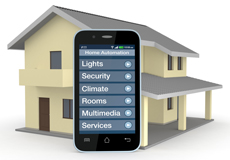 The term “Smart Home” continues to be kicked around, but what does it truly mean for home security? According to Blake Kozak, senior analyst for Security and Building Technologies at HIS, the answer is change. “For years, consumers have depended on the services of traditional monitoring stations and alarm companies,” says Blake. “Equipment was simple, and easy to use and did what it needed to do. Then in 2007, came the first iPhone from Apple, one of the first cell phones to deploy a multi-touch interface and in 2008 the release of Android, an open-source platform. Two releases that have changed the way in which consumers interact, not only with each other but other devices.
The term “Smart Home” continues to be kicked around, but what does it truly mean for home security? According to Blake Kozak, senior analyst for Security and Building Technologies at HIS, the answer is change. “For years, consumers have depended on the services of traditional monitoring stations and alarm companies,” says Blake. “Equipment was simple, and easy to use and did what it needed to do. Then in 2007, came the first iPhone from Apple, one of the first cell phones to deploy a multi-touch interface and in 2008 the release of Android, an open-source platform. Two releases that have changed the way in which consumers interact, not only with each other but other devices.
“Fast forward to 2014, the alarm industry is now in a period of change. On the back of smartphone deployments, alarm companies are now offering consumers the ability to interact with the equipment in their home. Forget to lock the door or close the garage? No problem, with a smartphone, the homeowner can resolve this issue with a click of a button. However, with new technology, comes new entrants and security companies now face stiff competition from other suppliers wanting to make a play in the home. With so much change and choice, where does the consumer turn?”
In its analysis of the “Smart Home” in relation to security equipment, IHS has identified three models that consumers can chose from when rolling out a “smart” security system.
The first security deployment type is ‘point security’, defined as hardware that does not link to other devices in order to generate automation, with each device having its own application. For example, many of the Z-Wave and WiFi garage door modules used today are often used independent of a total solution. Additionally, all-in-one devices such as Piper are defined as point security products even though there are capabilities to integrate more pieces of hardware.
The second type is ‘connected security’, which is a traditional burglar alarm system. All devices are connected to a panel, either hard-wired or wireless; with limited automation in place.
Lastly, ‘smart security’ is defined as devices that are linked together through one central point and one application can manage all devices.
“To date, globally, ‘connected security’ has gained the largest traction on the back of traditional monitoring companies,” says Blake. “However, more recently, the market has seen a shift and a movement towards smart security and point security [mostly across North America] as more DIY vendors appear in the market and end-users demand a seamlessly integrated home.
“As this trend to ‘smart’ takes place, IHS expects point security to benefit and grow since many of these products are used individually prior to being deployed in a single integrated solution. As a result, IHS anticipates that point security could be a gateway to more ‘smart’ systems.
“Overall, these three deployment types are important since they could help shape the future structure of the industry. For example, point security could be a gateway to bigger solutions and more integration within the home as end-users become accustomed to these devices. Alternatively, connected security has the longest track record, yet has failed to increase the overall penetration rate. As a result, the combination of point security, which often involves start-ups and little to no brand recognition, with connected security, which often involves long standing and proven brands, will likely lead to the new market of smart security.”

